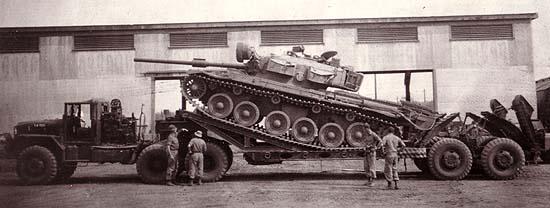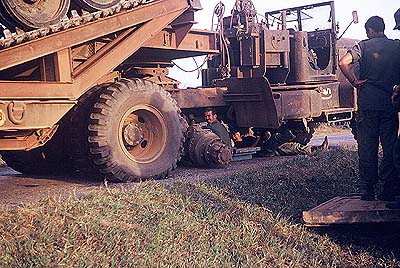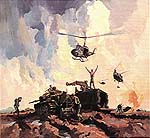Tank Transporter

In 1968, Capt Bruce Dittmar, OC 1 Armd Sqn Workshop, had talks with Maj Max Tinkler,OC, and Capt Don Cochrane (Wksp Mngr) at 102 Fd Wksp, about the problem of backloading a 53 tonne (52 ton) Centurion should it be so damaged in the field that it could not be made mobile under its own power.

The way it was usually done, was to remove the tracks and using the ARV, (Armoured Recovery Vehicle) skull drag it back on an “A” frame.
If the recovery was to the North of Nui Dat up Route 2, this method could be used. But directly East, up Route 15, meant you had to come back down the highway and through a large ravine just out of Baria that was sometimes in flood.

The other alternative was over a Bailey Bridge that had a 40 Ton rating on it. This bridge was just out of Baria and would take one Centurion, if care were used, but not an ARV towing a Cent on an 'A frame. This would need a Tank Transporter.
102 found that the most likely rig available in country, adaptable as a Centurion Tank Transporter, was a 40 Ton low loader and prime mover that the Americans had. Arrangements were made by 1ALSG to have an equipment added to the establishment of 85 Tpt Pl, 26 Tpt Coy, RAASC, Nui Dat.
102 Fd Wksp began developing a number of designs; that by Lt Marr, 102 Fd Wksp, a National Service officer, was considered to have most potential. The design was a steel
The design sketches were sent to Lt Jim Hislop, General Engineering Platoon, 106 Fd Wksp, Nui Dat while 85 Transport Platoon delivered the rig for modification and trial
We manufactured two A Frames and fitted them.
On 4 Dec 1968 Callsign 33Bravo, came across from C Sqn lines, with crew commander and driver, for the first trial loading at the back of the "Opera House", the A Veh Repair Shop. These are photos of this first trial.


Capt Russ Barker, Wksp Mngr with hand on hip

Inspecting (at the Gooseneck) Maj Norm Hicks-Hall (OC) and WO Bob Thompson, 106
It wasn't long before the modified tank transporter was needed to fetch a tank from Fire Support Base Julia. On 14 Dec 1968 a Centurion, coincidentally Callsign 33Bravo, had taken heavy mine damage that buckled and opened the belly plate and had taken out all systems.
The Transporter was dispatched with strict instructions, that when the tank was loaded, speed was to be kept to 10 to 15 KPH and every 10K the wheel nuts were to be checked, especially on the prime mover. (Didn't happen!)
At 1500hrs the same day of being dispatched, I was instructed to deploy an FRT up Route 15; about 10 clicks past the Baria Bridge to repair damage to the Prime Mover. With me were WO John Putland, Art Veh, my tent mate, and Cpl Gavin Bicknell, Veh Mech.
We arrived about 1600hrs to find the low loader, complete with tank. All the wheel studs had sheared off the forward axle of the rear bogey. The axle was literally on the road. Route 15 was completely blocked.

WO John Putland and Cpl Gavin Bicknell working under prime mover
Cpl Morrison, Fitter's Track driver on rear hatch of Fitters Track
We got straight to work, used 50-ton jacks and lifted the trailer off the prime mover. It was clear that we needed another prime mover and that the damaged one needed to be recovered.
I got on the radio and organised a replacement vehicle, the recovery and an escort to give us some protection. Task Force HQ and 106 Fd Wksp organised everything for us, which included, 2 US APCs complete with 30 Cal. MG and crews. The recovery of the damaged prime mover was quickly done by the US; they headed straight off towards Baria.
We got our act together, attached the serviceable replacement prime mover to the trailer, and packed up. Then, with an APC up front, me behind the Transporter and the other yank APC behind me, we were ready to move off.
By this time its pitch black and there is a lot of movement on the road by black pyjama clad people with arms. I decided that stealth was a waste of time so I instructed that all lights were to be put on, including the prime mover that had unprotected headlights. I also instructed the Americans that under no circumstances were they to fire on anyone, unless they were fired at. We looked like a circus as we slowly drove down the road to the Baria Bridge.
We got to the bridge, and I told the first track to proceed over and wait clear on the other side. I then told the driver of the low loader, to proceed at an even speed and not to stop. All this was done on the radio. The driver told me that he wouldn't proceed as he thought that the bridge would collapse and he would end up being killed.
I came up on the air and told him that the bridge was capable of taking the load, as it was an Australian Bailey Bridge. He again refused and I told him he wouldn't have to worry about the bridge killing him, I would, if he didn't get across the bridge and do as he was told. He drove across, the side rails quivered and snaked a bit but the vehicle safely crossed.
I had worked out that the all up load on the bridge would be about 60Ton. From my engineering experience I also knew that all bridges that were manufactured in Australia were rated at 1/3 of their breaking strain. I was also fully aware that the Commanders of both 102 and 106 Fd Wksps wouldn't be using a low loader with a tank on it if it wasn't possible to drive it across the Bailey Bridge at Baria.
We all got safely back to 106 Fd Wksp at Nui Dat. Lt Hislop had made arrangements to accommodate our American Escort and to feed us all. By this time it's well after midnight.
Next day I found out that the Task Force HQ had informed the Area Commander, Col Don Dunstan of my threat to the driver, if he didn't cross the bridge as ordered. Both Maj Hicks-Hall and Lt Jim Hislop had said nice things about me, but I still had to report to Colonel Dunstan at his quarters situated in among the rubber trees.
Colonel Dunstan knew me from the days that I was the Task Force Armour and later as the EIS GE Inspector. A couple of times I had given adverse reports to TF Units. Those days I would inspect a unit and immediately write out the report and hand it to the Unit Commander if it was adverse this usually meant me seeing Col. Dunstan, but that's another story.
Col Dunstan asked me how I knew that the bridge wouldn't collapse under the combined weight of the tank and its loader and I explained the bridge rating system, and my faith in the people that proposed the operation in the first place, the Unit commanders of both 102 & 106 Fd Wksps
He advised me not to threaten people in future and said I did a good job. I didn't hear anymore about it.


